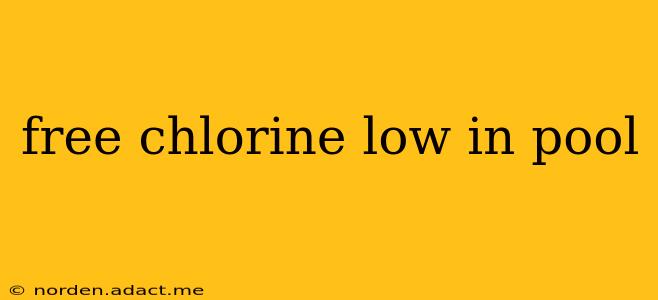Maintaining the proper free chlorine levels in your swimming pool is crucial for keeping it clean, safe, and enjoyable. Low free chlorine levels can lead to algae growth, cloudy water, and even pose health risks. This comprehensive guide will help you understand why your free chlorine might be low, how to address the problem, and how to prevent it from happening again.
Why is My Free Chlorine Low?
Several factors can contribute to low free chlorine levels in your pool. Understanding these factors is the first step towards effective troubleshooting.
-
Insufficient Chlorination: This is the most common cause. You might not be adding enough chlorine, or your chlorine source might be ineffective or degraded.
-
High Levels of Contaminants: High levels of organic matter (like leaves, sweat, sunscreen, and other debris) and other contaminants consume chlorine, depleting its levels rapidly. Regular cleaning and filtration are essential.
-
Sunlight Degradation: Sunlight can break down chlorine, especially in pools with direct and prolonged exposure.
-
Ineffective Filtration: A poorly maintained or undersized filter system won't effectively remove contaminants, leading to faster chlorine depletion. Regular backwashing and filter cleaning are vital.
-
Incorrect pH Levels: A pH level that's too high or too low can affect the effectiveness of chlorine, making it less efficient at sanitizing the water.
-
Improper Chemical Balance: Other chemical imbalances, such as low alkalinity or high cyanuric acid (stabilizer) levels, can also impact chlorine effectiveness.
-
Algae Growth: Algae consume chlorine, accelerating its depletion. If you see signs of algae, immediate action is necessary.
How Do I Raise My Free Chlorine Levels?
Once you've identified the cause of low free chlorine, you can take steps to raise the levels. Remember to always follow the instructions on your chosen chlorine product.
-
Add Chlorine: The most straightforward solution is to add more chlorine to your pool. Use a test kit to measure your current levels and add the appropriate amount to reach the recommended range (typically 1-3 ppm). Granular chlorine, chlorine tablets, and liquid chlorine are common options.
-
Shock the Pool: Shocking your pool involves adding a large amount of chlorine to quickly oxidize contaminants and kill bacteria. This is especially helpful if you have a sudden drop in free chlorine or suspect algae growth.
-
Clean the Filter: Ensure your filter is clean and functioning correctly. Backwash your filter regularly, according to the manufacturer's instructions.
-
Adjust pH Levels: Balance your pool's pH to the ideal range (7.2-7.8). This will optimize chlorine's effectiveness.
-
Address Other Chemical Imbalances: Test for other chemical imbalances (alkalinity, cyanuric acid) and adjust accordingly. Improper balances can interfere with chlorine's sanitizing ability.
-
Regular Cleaning: Remove leaves, debris, and other contaminants regularly to minimize chlorine consumption.
What are the Signs of Low Free Chlorine?
Recognizing the signs of low free chlorine is key to preventing major problems. Common indicators include:
- Cloudy or Murky Water: Low chlorine allows particles to remain suspended in the water, resulting in cloudiness.
- Algae Growth: Algae blooms are a strong indicator of insufficient chlorine levels. You might see green, brown, or black discoloration on the pool walls, floor, or surface.
- Unpleasant Odor: Stagnant water with low chlorine can develop a foul smell.
- Eye or Skin Irritation: While properly balanced chlorine is not typically irritating, low chlorine levels combined with other imbalances can cause discomfort.
How Often Should I Test My Pool Water?
Regular testing is crucial for maintaining proper chemical balance and preventing problems. Aim to test your pool water at least twice a week, more often during hot weather or periods of heavy use.
How Can I Prevent Low Free Chlorine in the Future?
Prevention is key to maintaining healthy chlorine levels. Consider these strategies:
- Regular Testing and Balancing: Consistent testing and adjustment of chemicals are crucial.
- Proper Filtration: Maintain a clean and efficient filter system.
- Regular Cleaning: Remove debris and contaminants promptly.
- Appropriate Chlorine Dosage: Use a chlorine calculator to determine the correct amount of chlorine to add based on your pool's volume.
- Consider a Chlorine Generator: Saltwater chlorinators automatically generate chlorine, reducing the need for manual additions.
By understanding the causes of low free chlorine, addressing the problem effectively, and implementing preventative measures, you can ensure your swimming pool remains clean, safe, and enjoyable throughout the season. Remember to always consult your pool professional if you have any doubts or persistent issues.
